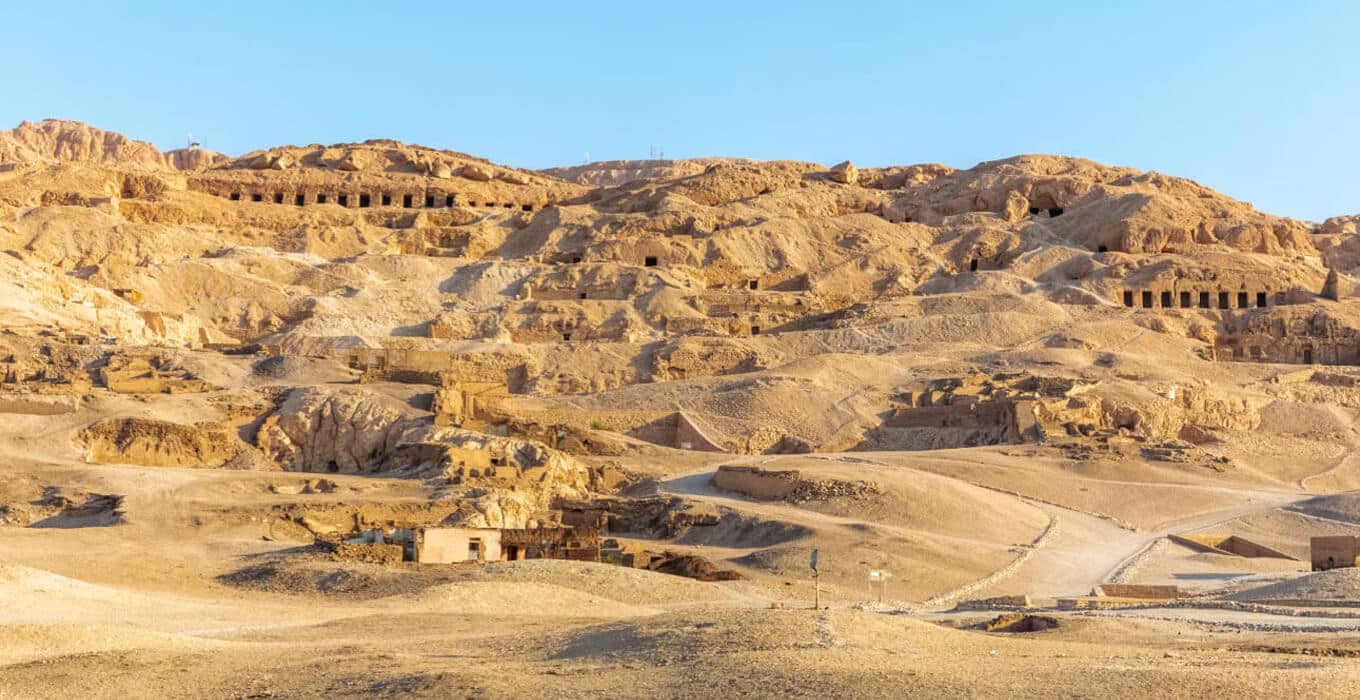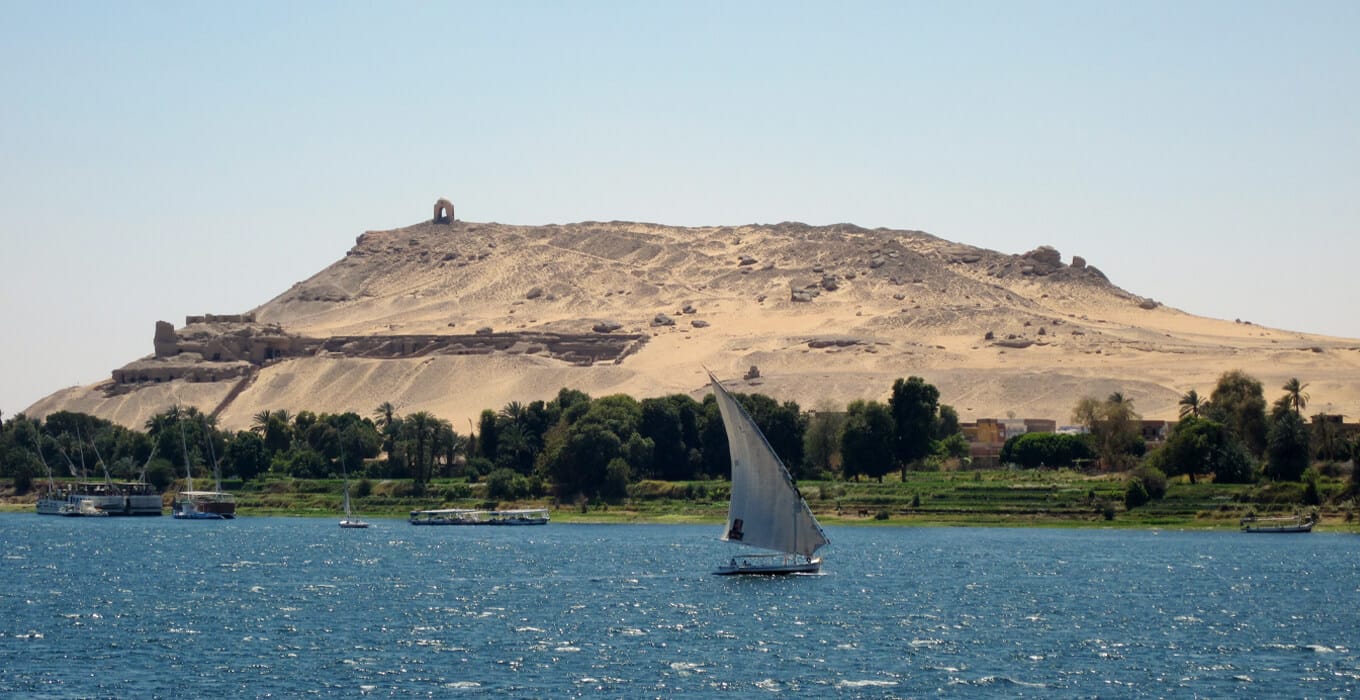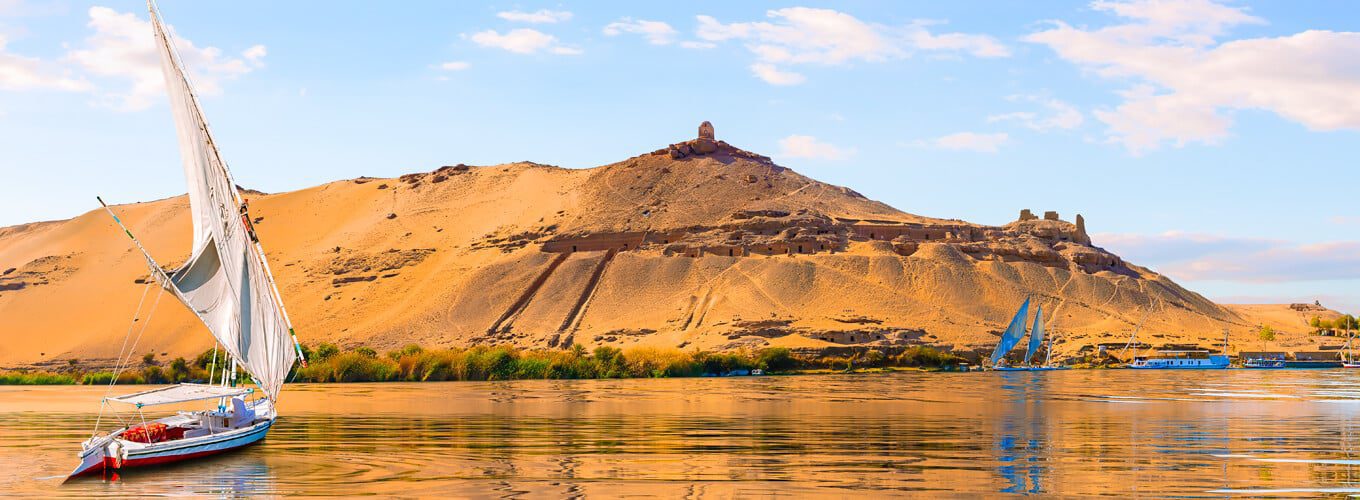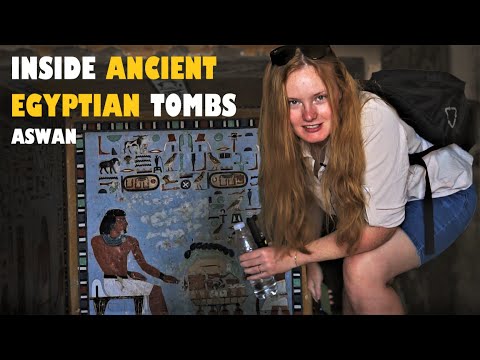In Aswan, Egypt, by the Nile River, the Tombs of Nobles Aswna are a sight to see. They show the wealth and power of ancient Egyptian nobles. These tombs from the Old and Middle Kingdoms let us peek into the lives of the elite.
There are over 30 graves in the Tombs of the Nobles, all carved into sandstone cliffs. The oldest tomb, Harkhuf’s, goes back to the 6th dynasty, around 2345 to 2181 BC. It’s one of the earliest and most important burial spots in the area.
Key Takeaways
- The Tombs of the Nobles in Aswan, Egypt, date back to the Old and Middle Kingdoms, spanning from 2500 BC to 2000 BC.
- The site consists of over 30 individual rock-cut tombs, each offering a unique insight into the lives and afterlife beliefs of ancient Egyptian nobility.
- The Tomb of Harkhuf, one of the oldest in the necropolis, dates back to the 6th dynasty, between 2345 and 2181 BC.
- The Tomb of Sarenput II is considered one of the finest and best-preserved among the nobles’ tombs in Aswan, belonging to the Middle Kingdom era.
- Lord Greenville, a British archaeologist, was the first to formally explore and document the Tombs of the Nobles in Aswan between 1885 and 1886.
Introduction to the Tombs of Nobles in Aswan
The city of Aswan sits by the Nile River. It’s full of Aswan History and culture. Elephantine Island was home to Nubia’s rulers long ago. Here, the Tombs of the Nobles show us the lives of Ancient Egyptian Nobility. They lived in the Old Kingdom and Middle Kingdom times.
Historical Overview of Aswan and Elephantine Island
Aswan is at Egypt’s southern edge. It was a key city because of Elephantine Island. This island was a cult center for gods like Khnum, Satis, and Anubis. It made the island very important for Archaeological Significance.
Significance of the Tombs of Nobles as Archaeological Sites
The rock-cut tombs near Elephantine Island tell us a lot about ancient Egypt. They give us a peek into the lives of the Egyptian elite in the Old Kingdom and Middle Kingdom. These sites are a treasure for scholars and visitors. They let us explore ancient Egyptian society and how they buried their dead.

The Discovery and Exploration of the Tombs
The Tombs of the Nobles in Aswan, Egypt, have amazed archaeologists and history fans. Lord Greenville, a famous British archaeologist, found and studied these tombs in 1885 and 1886. His archaeological expeditions were key to learning about the nobles buried there.
Lord Greenville’s Archaeological Expeditions
Lord Greenville’s Tomb Discovery work in Aswan was a big deal. He looked closely at the tombs’ design, paintings, and objects. His work helped us understand these Archaeological Expeditions and the nobles’ lives today.
Recent Excavations and Findings
Since Lord Greenville’s time, more Tomb Findings have been made. Recent Excavations have given us new insights. They’ve made our knowledge of these tombs and ancient Egyptian culture even better.
“The Tombs of the Nobles offer a glimpse into the lives and legacies of ancient Egypt’s most influential figures, whose stories are etched into the very walls of their final resting places.”
The Tomb Discovery and study of the Tombs of the Nobles in Aswan still amaze scholars and visitors. They help us learn about these ancient wonders and the Archaeological Expeditions that found them.
The Tomb of Mekho and Sabni
In Aswan, Egypt, by the Nile River, the tombs of Mekho and his son Sabni are found. They show the design and layout of the Tombs of the Nobles. Mekho and Sabni were governors under Pharaoh Pepi II. Their tombs tell us about the burial customs and importance of these high-ranking people in ancient Egypt.
Architectural Features and Layout
The tombs have a special staircase that was made for the burial rituals. Inside, you’ll see columns, reliefs, and inscriptions. These show the lives and achievements of Mekho and Sabni.
Sabni’s Heroic Journey to Retrieve His Father’s Body
Sabni’s tomb stands out with its reliefs of his journey to get his father’s body back from a war. These scenes show how important it was to bury the dead right in ancient Egypt. It was key for the dead to make it to the afterlife.
Meko’s tomb (Tomb NO 25) is full of life with its decorations. You’ll see everyday scenes, farming, and reports given to him. It has 18 columns with prayers, farming scenes, and rituals.
Sabni’s tomb (Tomb NO 26) is the biggest in the Tombs of the Nobles. It shows his hunting, finding his father’s body, and leading armies. The tomb has columns with hunting and fishing scenes. It tells of his army going to Nubia and bringing back his father’s body.
|
Tomb |
Architectural Features |
Condition Rating |
Ambience Rating |
Access Rating |
Accuracy of Coordinates |
|
Tomb of Mekho |
18 columns, prayers, agricultural scenes, rituals |
4 |
4 |
4 |
5 |
|
Tomb of Sabni |
Hunting, fishing, Nubia expedition, body recovery |
5 |
5 |
4 |
5 |
The Magnificent Tomb of Sarenput II
The Tomb of Sarenput II is in Aswan, Egypt, among the famous Tombs of the Nobles. It shows the Middle Kingdom’s skill in architecture and art. It dates back to Pharaoh Amenemhat II’s time.
Visitors see six big pillars at the entrance. These lead to a corridor with statues of Sarenput II. The burial chamber is where the real magic is. Here, walls show scenes of hunting, fishing, and Sarenput’s family life.
These paintings are a treasure. They show the amazing skill of the artists. They also tell us about the daily life and customs of the Aswan nobility.
|
Condition Rating |
Ambiance Rating |
Access |
Coordinate Accuracy |
|
3 |
4 |
4 |
4 |
The Tomb of Sarenput II shows the deep culture and history of Aswan’s Middle Kingdom Tombs. It’s in good shape, rated 3 out of 5, and has a great feel, rated 4 out of 5. It’s perfect for those who love history and art. The tomb’s design and the detailed paintings make it a memorable visit to Egypt’s past.
Tombs of Nobles in Aswan, Egypt
The Tombs of the Nobles in Aswan, Egypt, are famous for their well-preserved and colorful wall paintings. These paintings show us the daily lives of the ancient Egyptian elite. They are engaged in activities like hunting, fishing, and farming.
This gives us a peek into their lifestyles and traditions.
Vivid Wall Paintings and Daily Life Depictions
The tomb interiors have vivid wall paintings that make the ancient world come alive. These artworks show nobles doing everyday tasks. They could be tending to their crops, managing their servants, or enjoying their free time.
The detail in these paintings is amazing. It lets visitors feel like they are part of ancient Egyptian life.
Hieroglyphic Inscriptions and Historical Records
The tombs also have lots of hieroglyphic inscriptions. These are like historical records. They tell us about the nobles’ titles, achievements, and beliefs about the afterlife.
By studying these inscriptions, scholars have learned more about the lives and legacies of these ancient Egyptian elites.
The Tombs of the Nobles in Aswan let us peek into the past. We see Tomb Wall Paintings, Ancient Egyptian Daily Life, and Hieroglyphic Inscriptions in the Aswan Tomb Interiors. These treasures show us the world of the ancient Egyptian nobility. They invite us to explore their rich cultural heritage.

The Tomb of Harkhuf: Explorer and Trader
In Aswan’s ancient necropolis, the tomb of Harkhuf is a key piece of history. Harkhuf was a governor under Pharaoh Pepi II. His tomb shows the strong trade and diplomatic links between ancient Egypt and its southern neighbors.
The walls of Harkhuf’s tomb have amazing hieroglyphics. They tell us about his four trips to Nubia and central Africa. These stories are a peek into his adventures.
Accounts of Expeditions to Nubia and Central Africa
Harkhuf’s journeys took him through tough Nubian terrain and vast central Africa. He made strong connections in trade and culture. His stories are key to understanding ancient Egypt’s trade network.
The Enigmatic “Dancing Pygmy”
A “dancing pygmy” is a mystery from Harkhuf’s tomb. Pharaoh Pepi II wanted this rare being in his collection. It shows how important these trips were, not just for trade but also for culture and politics.
The Tomb of Harkhuf celebrates the bravery and business skills of ancient Egyptian explorers and traders. Its inscriptions give us a glimpse into the past. They reveal the complex web of trade and culture that linked the Nile Valley to central Africa.
The Tomb of Hekaib: Warrior and Overseer
The Tomb of Hekaib, also known as Pepinakht, tells the story of a military leader. He was an overseer of foreign soldiers during Pharaoh Pepi II’s rule. The tomb shows his key missions to stop rebellions in Nubia and Palestine.
These missions were crucial for keeping Egypt safe from threats. Hekaib played a big part in protecting Egypt’s borders.
Quelling Rebellions in Nubia and Palestine
Hekaib was known for his bravery in fighting against uprisings in Nubia and Palestine. He was a key person in the Egyptian government. His work helped keep the Pharaoh and the empire safe.
Hunting and Battle Scenes
The tomb also shows Hekaib’s skills as a warrior through hunting and battle scenes. These scenes are full of life and action. They tell us about Hekaib’s strength and the importance of war in ancient Egypt.
The Tomb of Hekaib is a special place that shows us the many roles of important people in ancient Egypt. It tells us about their military actions, their jobs, and their lives during Pharaoh Pepi II’s time.
The Tomb of Sarenput I: Governor and Family Man
The tomb of Sarenput I is a key piece of history. It shows us what life was like for a high-ranking official in ancient Egypt. Located on the west bank of the Nile in Aswan, it gives us a peek into the life of a powerful noble.
Decorated Pillars and Reliefs
Sarenput I’s tomb has six decorated pillars. They feature reliefs that show the governor with his dogs, a sandal-bearer, harem, wife, and sons. These scenes capture his life, from his official duties to his family life.
Depictions of Daily Life and Household
The tomb’s walls are filled with paintings and reliefs. They show Sarenput I and his family’s daily life. You can see scenes of fishing, hunting, and the governor with his staff and family. These scenes give us a rare look at the life of a noble in ancient Egypt.
The tomb of Sarenput I is a treasure of ancient Egyptian culture. Its decorations and historical details let us connect with the Aswan nobles of the past.
Visiting the Tombs: Practical Information
Exploring the Tombs of the Nobles in Aswan, Egypt, is a must for travelers. It’s a deep dive into ancient history. You’ll need to go to the West Bank of the Nile River. There, stairs lead up to the tomb complex.
Getting to the Tombs of Nobles from Aswan
The Tombs of Nobles are close to Aswan. You can take a ferry across the Nile River for EGP 5 (€0.15/$0.16) each. Or, you can take a boat ride from the Mausoleum of Aga Khan for $2.10.
Opening Hours and Guided Tours
The Tombs of Nobles are open to everyone. Hours change with the seasons. You can go alone or join a guided tour for deeper knowledge.
Guided tours cost about $1.31 per person. They’re a great way to learn more about the tombs.
For a deeper experience, visit the Monastery of St. Simeon. It costs EGP 40 (€1.24/$1.31) per person. There, you can learn about the area’s history and culture.
Enjoy a local lunch in a Nubian village for just $1.10 for two. It’s a chance to taste real local food.
Whether alone or with a guide, visiting the Tombs of Nobles is unforgettable. It’s a journey into Aswan’s rich culture.
Preserving the Legacy of the Tombs
The Tombs of the Nobles in Aswan, Egypt, show us the rich culture of the area. They let us peek into the lives of ancient Egyptian leaders. But, these important sites are facing big challenges to stay safe.
They are at risk from the weather and people. The old buildings and beautiful paintings need special care.
Conservation Efforts and Challenges
Archaeologists and experts are working hard to save the Tombs of the Nobles. They are fixing up the buildings, keeping the paintings safe, and controlling the environment. This helps protect them from temperature and humidity changes.
But, the tombs still have many problems. Too many visitors, weather damage, and constant upkeep are some of them. These issues make it hard to keep the sites safe.
The Importance of Responsible Tourism
Many tourists visit the Tombs of the Nobles in Aswan. It’s a chance to see ancient Egyptian life up close. But, too many visitors can harm the site.
So, it’s important to have rules for visitors. This means not letting too many people in and taking care of the site. This way, the tombs can stay interesting for visitors and safe for the future.
By finding a balance, we can keep the sites open to everyone. This helps teach people about history while protecting the Tombs of the Nobles. The work to save these sites shows our commitment to preserving Egypt’s history and promoting tourism that cares for the environment.
Conclusion
The Tombs of the Nobles in Aswan, Egypt, show us the deep culture and history of ancient Egyptian nobility. These tombs from the Old and Middle Kingdoms let us peek into the lives and beliefs of the elite. They show us the beauty and complexity of Egypt’s ancient times.
These tombs are a key spot for those wanting to dive deep into the Nile Valley’s history. They are known for their stunning art, deep history, and insights into ancient Egyptian nobles’ lives. They remind us of the lasting effect of this amazing civilization.
The Tombs of the Nobles in Aswan, Egypt, highlight the area’s importance in archaeology and Ancient Egyptian History. These tombs, from the Old and Middle Kingdoms, give us a special look into the lives and beliefs of the nobles. Through their art, writing, and design, visitors can better understand the grandeur of Egypt’s ancient times.
Read our related articles:

